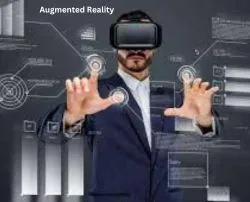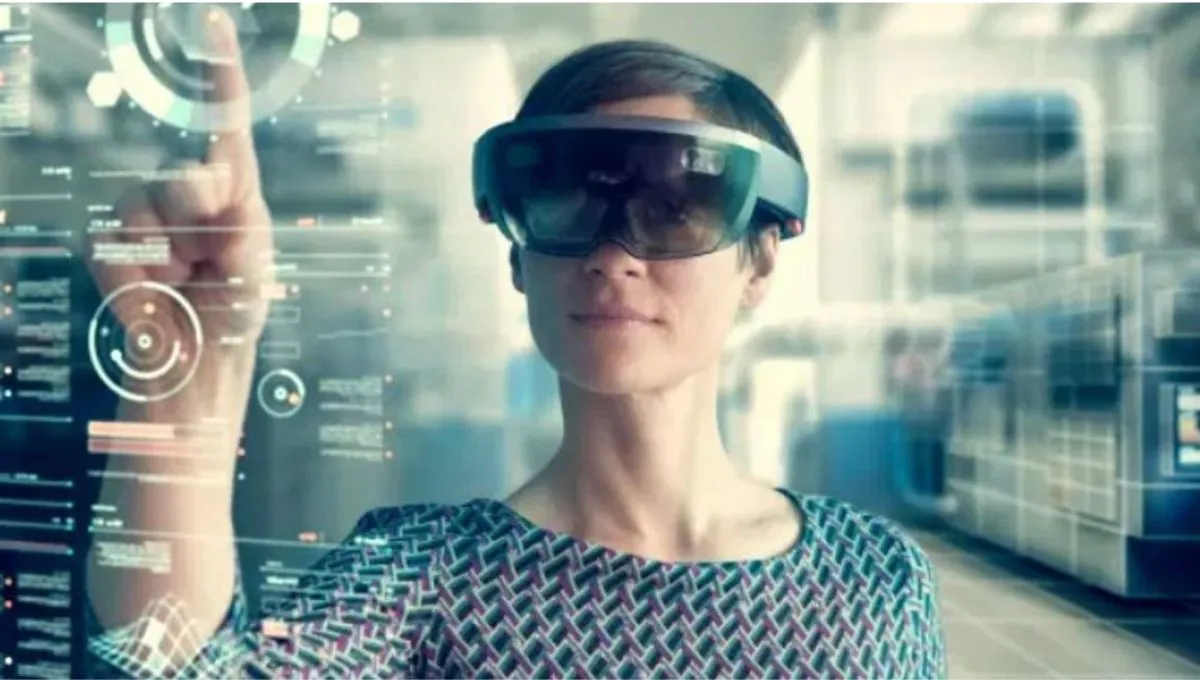Introduction
Augmented Reality Games together experience this technological transformation and American businesses in both healthcare and entertainment lead through augmented reality development while the business world. Augmented Reality (AR) represents one of multiple fascinating technological innovations because of its rapid development in recent times. Advancements in AR technology generate the primary question about whether these new systems will replace smartphones in the future. The technology of AR requires investigation of its present capabilities and future obstacles together with projections about its development within the technological realm.

Understanding Augmented Reality (AR)

What is AR ?
Users can enjoy digital elements such as visual and audio components and three-dimensional objects which Augmented Reality (AR) shows together with physical surroundings through device or wearable display screens. Virtual Reality technology distinguishes itself from Augmented Reality because it develops separate virtual worlds whereas AR enhances real environments through virtual elements.
How AR Differs from VR
- AR technology functions by boosting reality conditions despite being different from VR because this technology creates fully virtual experiences that exclude users from the real world.
- The access methods for AR consist of smartphones alongside AR glasses yet users need specialized VR headsets to receive the technology experience.
- Through its technology AR let’s users handle simulated objects while maintaining contact with physical things whereas VR isolates people fully in synthetic environments.
Key Features of AR Technology
- Real-time interaction with the environment
- Advanced object recognition
- Integration with AI for enhanced experiences
- Accessibility through various devices
The Rise of Augmented Reality in Modern Tech

Evolution of AR from Concept to Mainstream
Previous to its actual existence AR remained only within the realm of science fiction before becoming usable as practical technology that spreads across various fields. Several AR applications like Pokémon GO and IKEA Place deliver experiences further than what anybody could have predicted originally. Users encounter a growing number of futuristic Augmented Reality Games platforms that merge modern technology with entertainment value.
Industries Leveraging AR
- Gaming & Entertainment: AR-based games together with immersive experiences fall into the Gaming & Entertainment sector.
- Healthcare: AR-assisted surgeries and medical training.
- Retail & E-commerce: The combination of virtual try-ons with AR-powered shopping platforms operates within the retail and e-commerce sectors.
- Education: Interactive learning experiences.
- Real Estate: Virtual property tours.
AR-Powered Devices
- The modern mobile phones with AR functions exist in iPhone and Samsung Galaxy phones and their successors.
- AR smart glasses (Microsoft HoloLens, Google Glass, Apple Vision Pro)
- AR headsets for Gaming companies along with enterprise departments for their operations.
The Role of Smartphones in Today’s World

The current population relies on smartphones because they provide essential communication abilities alongside serving work needs and entertainment needs. Devices have continuously advanced into modern smartphones which provide top-quality camera technology alongside AI connectivity as well as cloud-based features.
Why Smartphones Dominate Modern Life
- Portable and multifunctional
- Advanced connectivity (5G, Wi-Fi, Bluetooth)
- High-resolution touchscreens
- Integration with AI and IoT devices
How Smartphones Have Evolved Over Time
Smartphones produced by Nokia in the past have progressed into iPhones and Android versions which deliver superior performance features including speed and cameras and user interface convenience alongside the still-advanced capability of Augmented Reality Games applications.
Can Augmented Reality Replace Smartphones?

Users may achieve the displacement of current smartphone usage with AR wearables although the effort involves substantial risks. This paper considers the benefits as well as drawbacks of adopting AR technologies instead of smartphone devices. Augmented Reality Games together experience this technological transformation.
Potential Benefits of AR Over Smartphones
- Hands-Free Operation: These devices avoid hand interactions because projections directly display information inside the AR glasses.
- Enhanced Productivity: AR technology enables users to improve productivity through instant translation services that guide them to collaborative features which boost their work output.
- Immersive Experiences: Augmented Reality Games create full-bodied interactive gameplay because of immersive technological additions.
- Improved Communication: Video calls featuring augmented reality technology alongside remote teamwork capabilities will get significant capability improvements because of its augmented reality technology.
AR Wearables: The Next Big Thing?

Introduction to AR Smart Glasses & Headsets
The technology firms Apple and Microsoft team up with Meta to spend substantial capital on developing AR wearables. The technological leaders of augmented reality space consist of Apple Vision Pro together with Microsoft HoloLens and Meta AR glasses who define the present capabilities of augmented reality. Augmented Reality Games together experience this technological transformation.
How AR Wearables Could Function as Smartphone Alternatives
- Display information directly on lenses.
- Allow voice and gesture control.
- Through the system users can access immediate navigation features along with virtual support features in real time.
- Provide an immersive entertainment experience.
- Immersive gaming together with media consumption reflects as a core feature for Augmented Reality Games.
Limitations of Augmented Reality Technology

Technical Challenges
- Battery life limitations.
- Limited field of view in AR glasses.
- High processing power requirements.
Privacy and Security Concerns
- Potential risks of data breaches
- Ethical concerns regarding constant surveillance
Cost and Accessibility Barriers
- The market value of AR wearables surpasses what consumers can obtain for smartphones.
- Lack of widespread adoption.
User Adoption and Market Readiness

Are Consumers Ready for an AR-Powered World?
The audience who enjoys Augmented Reality Games joined by a growing community still favors using easy-to-use smartphones of affordable prices.
The Impact of AR on Daily Life
Under an AR-controlled environment every part of daily life existence would undergo transformation that affects both employment settings and shopping practices and social and entertainment functions. Augmented Reality Games would transform ordinary life if they integrated with real-world activities thus converting commuting into a digital treasure hunt experience.
How Long Until AR Becomes Mainstream?
The adoption of AR technology is predicted to take ten years to develop into mainstream everyday use for replacing or minimizing smartphone requirements. Augmented Reality Games together experience this technological transformation.
The Future of AR and Smartphones

Will AR and Smartphones Coexist?
AR technology will partner with smartphones to improve device capability without replacing their functions. Augmented Reality Games together experience this technological transformation.
Predictions for the Next Decade
- More affordable AR devices.
- Advanced AI-driven AR experiences.
- The alliance of 6G technology with cloud computing produces enhanced communication network capabilities.
- Rise of more immersive Augmented Reality Games and entertainment platforms.
Industry Experts' Opinions
Technology leaders anticipate that AR technology will evolve into an experience transformation tool that supports smartphones in the upcoming ten years. Augmented Reality Games together experience this technological transformation.
Conclusion
Smartphones continue as the main technology interface because Augmented Reality lacks the ability to replace their current functionality within the next ten years. The upcoming hybrid environment will benefit from AR technology advancements making smartphones more functional in digital interaction. Mobile technology will advance alongside Augmented Reality games and business applications and communication tools. The development of AR technology will transform human work practices and communication approaches and reshape entertainment dynamics.
FAQs
1. What is the main difference between Augmented Reality and Virtual Reality?
Virtual reality delivers complete virtual environments to users which are different from AR systems that place virtual elements over real-world surroundings.
2. Can AR smart glasses completely replace smartphones?
Not yet. The full achievement of AR glasses technologies remains a challenge because of both technological barriers together with adoption barriers and device pricing issues.
3. What are the biggest challenges preventing AR from replacing smartphones?
The adoption of AR to replace smartphones faces four main barriers because of limited device power duration as well as restricted processing power and elevated cost and fundamental data security needs.
4. Which companies are leading the AR revolution?
The professional AR division primarily belongs to Apple and Meta alongside Google and Microsoft which focus on creating wearable devices alongside Augmented Reality Games.
5. How long will it take for AR to become mainstream?
The implementation of AR technology will become standard practice in 5-10 years when smartphone popularity continues to endure in public life.






